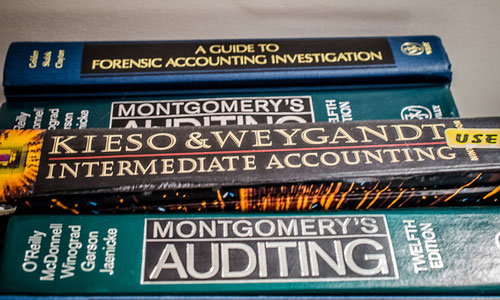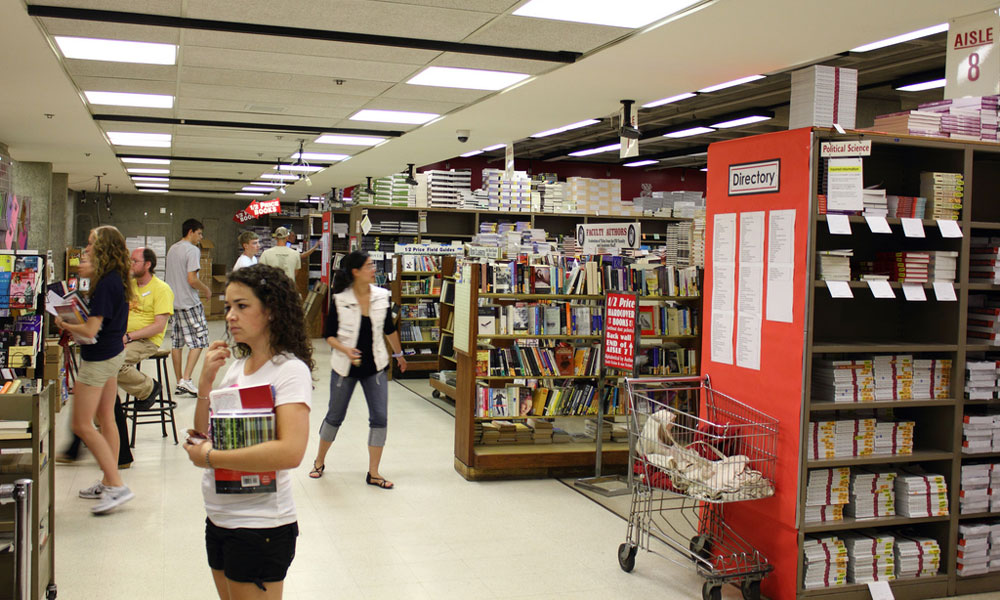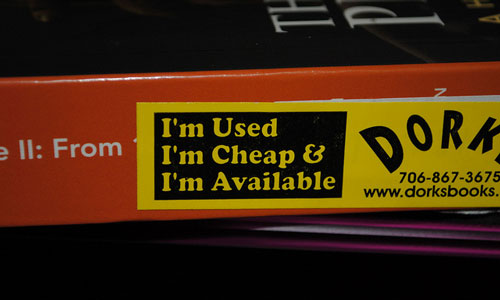Let's Teach Textbooks A Lesson
The prices of college textbooks are absurd—to the point where authors have to defend their $300 books. But we could, thankfully, be turning a corner.
1,041%
The estimated increase in prices for college textbooks between 1977 and 2015, according to an NBC News analysis of Bureau of Labor Statistics data—far outpacing inflation. (Hey, at least the food is cheap.) The story featured comments that disputed the data from both the Association of American Publishers and the National Association of College Stores, both of which noted that the pricing doesn't reflect what's actually happening in the real world—specifically, that books are commonly rented or sold used nowadays.

College professors didn't always rely on textbooks. What shifted?
Like graphing calculators, textbooks have a price that's artificially inflated based on its use case.
But it wasn't always that way—at some point, the way textbooks were produced fell out of whack with the expectations of students. Priceonomics suggests that the major upward shift in prices for college textbooks occurred sometime in the 1970s, and since then hasn't stopped.
What happened in the '70s? Let's ask someone from the '70s: In a 1975 piece for the The Annals of the American Academy of Political and Social Science, journalist Phillip Whitten, who spent time as running his own publishing firms, said that shifts in the uptake in textbooks, driven by a desire to standardize curriculum as well as to make things easier for students, led to a significant increase in the use of textbooks during this period.
But textbook companies of the era didn't have it easy. In his piece, Whitten crunched the numbers of a hypothetical textbook, one sold for $12.50 but generally offered to college stores at a wholesale price of $10. (In today's dollars, the book would have sold for $44.73 before markup by the bookstore—not a bad price, actually.)
In Whitten's example, the book sold 50,000 copies, netting half a million dollars in sales, but was offset by a variety of costs, including royalties, marketing, and manufacturing. Still though, the book made $79,000 in pre-tax profit, a solid 15.8 percent margin. But he noted that the game for publishers was generally not that easy, due to the existence of both fixed and variable costs.
"If Sociology in Modern World had sold 20,000 copies, we would have lost $75,000; had it sold 10,000 copies—and there are many texts that do not do even that well—our loss would have been greater than $126,000," Whitten wrote.
(How does that compare to the modern day? Priceonomics writer Zachary Crockett, who spent time working for a textbook publisher, breaks down the math similarly to Whitten, though these days, publishers tend to make $40 in pure profit on a $180 book—a 22 percent margin.)
To close out his essay on the subject, Whitten notes that the publishing space is growing increasingly competitive and implies only a few large publishers will survive.
Educational publishing, for the remainder of the 1970s, will not resemble at all the halcyon days of the late 1960s. In a time of economic retrenchment and static enrollments, only those publishers who can develop techniques to reduce their financial risk will survive; and only those publishers who can learn to produce quality books consistently, with the maximum innovative pedagogical features permitted by existing constraints, will prosper. It is a worthy challenge.
But that assessment didn't consider a fact we know is true at this juncture. College publishers soon figured out that all they had to do to improve their margins was raise prices and release numerous editions.
1933
The year that Princeton University, in the midst of the Great Depression, launched two efforts to help students struggling to make ends meet: An Emergency Loan Fund and a Student Loan Library, the latter made up of used books from students who had used them in prior semesters. It represents one of the earliest examples of the used book trade in colleges, one that picked up a few years later, when New York University students launched a used bookstore—the result of an outcry after four students were arrested for "peddling without a license."

One positive effect of higher book prices: More pictures
Another factor that may have played a role in the increase of college book prices may have been the proliferation of improved printing technology, which led to more visuals.
In the 1960s, it was somewhat uncommon for a textbook to have much in the way of pictures. Some books, like Knopf's History of the Modern World, had just a handful of pictures in their nearly 1,000 pages.
But by the 1980s, this changed, a change that was seen as generally positive for students, according to a 1986 study done by Georgia State University researchers Brenda D. Smith and Joan M. Elifson. The duo noted the picture-free material tended to be comprehended just as well as material with pictures, but students preferred the more vibrant option.
"Student preference proved to be overwhelmingly in favor of pictures," the researchers wrote. "Of the 145 students, 119 chose the passage with pictures, while only 26 chose the passage without pictures."
Smith and Elifson found that the level of pictures in many books increased dramatically between the 1960s and 1980s, but that students were largely in favor of this change.
What the study failed to mention is that this increase in photos and illustrations most assuredly raised editorial costs—because, let's face it, stock photos cost money—as well as publishing costs.
If you were a textbook publisher, you couldn't get away with two colors anymore. So that played a factor in driving up costs, too.
"Many teachers and college administrators report that paperbacks have had a noticeable effect upon the reading habits of students. The world of books suddenly appears more inviting. Students crowd bookstores to buy required volumes, stay to browse among the tastefully designed offerings and come away with several additional purchases whose colorful appeal they could not resist."
— New York Times scribe Edward A. Walsh, writing in the newspaper's Book Review about the growing popularity of paperback books in college courses circa 1960. Part of the appeal of these paperback tomes was the fact that their lower cost compared to hardcover books made them more accessible to the public. This was seen as a good thing by many professors interviewed for the piece. (Fun fact: Paperback books used to receive a lot of the same criticism that e-books currently do.)

How does this totally-broken economic model survive?
Last year, two separate incidents occurred raised the ire of textbook critics. In some ways, they kind of dovetail into one another.
The good professor, punished: Last October, Alain Bourget, an associate math professor at the California State University at Fullerton, received a formal reprimand after choosing not to give his students the $180 textbook recommended to him by the school, instead offering a cheaper $80 option, supplemented by online offerings. The school said this broke the rules, because he veered from the book every other introductory linear algebra course was using at the school. He fought the reprimand, but failed. (His hometown paper treated him like a hero.)
The economist who's made bank from a single book: Harvard University Economist Gregory Mankiw was raked over the coals by The Oregonian last year for the high cost of his tome Principles of Economics, an introductory book that sells on Amazon for $333.35 and can be rented on Chegg for $49.99. The absurdity of Mankiw's book, which exemplifies many of the economic disparities covered in the book, was further highlighted by writer Richard Read's story. When asked if he'd ever write an open-source textbook, Mankiw had this to say: "Let me fix that for you: Would you keep doing your job if you stopped being paid? Why or why not?" A fair point—until you realize that Mankiw has, by some estimates, made $42 million in royalties from this book alone.
What's fascinating about the second example is that the professor that brought the book to Read's attention, Mike Paruszkiewicz, notes that he assigns the tome reluctantly, though he admits that he wouldn't if it wasn't easy to rent it out or acquire prior versions for cheap.
But it's worth asking—if professors know these textbooks are absurdly expensive, why assign them? Well, the answer involves a couple of factors, basically: One, professors often don't actually know the prices of the textbooks, and two, sometimes the professors themselves wrote the book, giving them an economic incentive to force you to buy it. (The American Association of University Professors, while not opposing it entirely, discourages it.)
The former case is generally more common than the latter—with the Daily Texan noting earlier this year a case of a German book increasing in price from $90 to $200, catching both the professor and students off-guard.
Part of the issue, of course, is that professors have somewhat limited options when it comes to textbooks. Five major publishers represent 85 percent of the market.
Some, like Gregory Mankiw, see no problem with this state of affairs, because they benefit financially from this system—no matter how many packs of ramen noodles it costs each student. (810, I checked.)
It feels unfair. It also feels like it shouldn't cost millions of dollars to produce a single textbook. But publishers seem to think it's necessary.
When I was in college, I remember feeling like a genius because I spent a lot of time looking around Amazon and eBay, finding copies of the textbooks I needed, sometimes for ten cents on the dollar. It felt good to get one over on the man as I ate my Life cereal with rice milk.
My eBay victories came during the brief window after the launch of Napster, which introduced a lot of students to the power of the ethernet pipes in their dorms, but before the launch of the last big innovation in textbooks—the rental marketplace Chegg.
(Sure, electronic textbooks exist and they look snazzy, but they're a bad deal.)
Will textbooks ever move to the Napster model? Probably. In fact, it's already happening. OpenStax, a nonprofit project of Rice University, has been working to both release open-source textbooks and to tailor-make books for professors that can be sold at college stores for very low costs.
Community colleges, whose students feel the pain of textbook costs more acutely than students at larger schools, have been quick to jump on the open education resource model.
“The educational materials and publishing industry in five to 10 years will be completely remade, just as the music industry, the newspaper industry and the computer software industry were completely remade by the internet,” OpenStax's Richard Baraniuk told University Business in 2014.
Napster literally came out of a dorm room. Universities and their professors owe it to themselves to be inspired by the Napster ideal.
Publishers? Well, you had a good run—but this is going to be the new normal.
:format(jpeg)/2017/06/tedium082516--1-.gif)
/2017/06/tedium082516--1-.gif)

/uploads/ernie_crop.jpg)